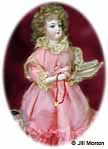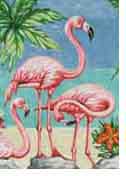Pink
Think Pink
Pink is a combination of the color red and white, a hue that can be described as a tint. It can range from berry (blue-based) pinks to salmon (orange-based) pinks. Its symbolism is complex and its popularity is subject to so many influences.
We can begin an analysis of pink by looking at natural and contemporary souces of this delicate color. First, regardless of your skin color, some part of your body is pink. So are sunsets, watermelons and Pepto Bismal. Depending on your age and culture, you may remember pink Cadillacs, pink flamingos (once considered in bad taste in American culture but now retro-chic), Pink Floyd, the Pink Panther, and the pink triangles of the Third Reich (which were used to identify male homosexuals).
 In almost every culture, one stereotype emerges: pink is associated with girls, blue with boys. Unfortunately, there is no consensus of opinion on its origin.
In almost every culture, one stereotype emerges: pink is associated with girls, blue with boys. Unfortunately, there is no consensus of opinion on its origin.
According to Jean Heifetz, for centuries, all European children were dressed in blue because the color was associated with the Virgin Mary. The use of pink and blue emerged at the turn of the century, the rule being pink for boys, blue for girls. Since pink was a stronger color it was best suited for boys; blue was more delicate and dainty and best for girls. And in 1921, the Women's Institute for Domestic Science in Pennsylvania endorsed pink for boys, blue for girls. (When Blue Meant Yellow. pp. 20 -21)
One could argue that contemporary color symbolism confirms these associations. Blue is considered a calm, passive color, hence feminine. Red (pink derived from red) is considered active hence masculine.

On the other hand, the idea of associating blue with male babies may stem back to ancient times when having a boy was good luck. Blue, the color of the sky where gods and fates lived, held powers to ward off evil, so baby boys where dressed in blue. In Greece a blue eye is still thought to have powers to ward off evil. The idea of pink for girls might come from the European legend that baby girls were born inside delicate pink roses.
Another theory states that the sexual origins can be found in ancient China. At a time when certain dyes were quite rare, pink dye was readily available and therefore inexpensive. Since blues were rare and expensive, it was therefore considered to be more worthwhile to dress your son in blue, because when he married the family would receive a dowry.

The origin of the English term "pink" is as valuable as any discourse on symbolism. Here are some interesting analyses:
In English, the word "pink" could be derived from the Dutch flower pinken dating back to 1681. The flower's name could have originally been "pink eye" or "small eye." Another possibility is the verb "to pink" - to prick or cut around the edges, as with pinking shears. The jagged petals of the flower looked as though they had been cut, thus explaining why it became known as the "pink." (Jean Heifetz, When Blue Meant Yellow, p 110)
 Finally, going back to the ancient Egypt, the flamingo was the hieroglyph for the color red.
Finally, going back to the ancient Egypt, the flamingo was the hieroglyph for the color red.
In colloquial language, to be "tickled pink" describes a state of joy, a "pink slip" is a notice that you've been fired from your job, to be "in the pink" suggest good fortune and health, and a "pinko" is a person who is extremely liberal, a socialist or a communist.
Visitors to Color Matters provide some interesting information about pink:
"Amongst the Owambo people (of Namibia), traditional wealth for the women has come in the form of a particular pink snail shell which is found in the extreme north and up into Angola. These snail shells are collected then cut into circular pieces, rubbed until they are all perfectly round and the same size and then beaded together. The richer the woman, the more strands of snail shell necklaces she has. They are very precious. These days the shops sell plastic versions, of course! What I have also seen in recent times is Owambo women in dresses which they say are traditional dresses, which have quite a bit of pink in them."
"With parakeets the male's nose is blue and the female's is pink."
"In Belgium they dress boys in pink and girls in blue. "
In conclusion, consider the following: Although sunburned skin and watermelons are pink's natural associations, the color is loaded with historical meaning, knee-jerk reflexes and cliches. In some cases, it is quite appropriate; in others, perhaps the only cliche worth using is one, which is ripe for a vivid transformation.
More about pink:
![]()
Can pink jail cells calm angry prisoners?
See Drunk Tank Pink
Also from Color Matters
Download this eBook in seconds.
Learn Online

Trustworthy color formulas for logos and branding
An eCourse from Jill Morton, Color Matters author & consultant.




